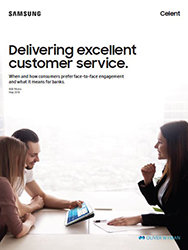As banks incorporate FinTech to satisfy consumer preferences for convenience and speed, they need to remember that customer relationships also depend on great experiences in branch offices.
FinTech is red hot both for banks and the outsiders seeking to disrupt traditional banking models. While banks are setting up their own programs and use and manage Fintechs, FinTech startups are continuing to attract venture capital interest to the tune of $5.4 billion in the first quarter of 2018 alone.
The popular storyline about nimble non-bank startups capturing hearts and minds with singular, focused digital applications might make for compelling copy, but it’s proving to be more fairy tale than nonfiction.
Despite pronouncements of doom, the facts tell a very different story. Financial services just had its most prolific quarter ever, as industry profits soared 28 percent during the first quarter of 2018 to $56 billion. While there has indeed been a tremendous shift in spend — arcing heavily toward digital development — recent surveys have shown that banks’ physical locations, and the person-to-person relationships formed there, are crucial in generating new business. Those locations affect which banks customers choose, where they establish credit and get mortgages, how they pay off debt like student loans, and how they make significant long-term investment decisions such as the decumulation of wealth.
Rather than being the predicted millstone, branches have continued to help banks retain relationships — in spite of the influx of new digital experiences. According to a recent Celent report, “the majority of US adults (55 percent) prefer in-person interactions with their bank when a conversation is needed.”
Welcome News for Banks as New Branch Strategies Unfold
Personal connectivity also seems to matter more to millennials — now aged 22 to 37 — than one might have expected. Customers are seeking out authenticity and empathy, which new technologies alone can never deliver. A recent global study of 15,000 financial consumers by PwC suggests a growing disconnect between financial brands and customers around their ability to deliver a personal customer experience purely through digital. While “speed, convenience, consistency, and friendliness are key to good customer experiences, there is one big connector to them all: human touch,” the study states.
Today, deployment and adoption of personalized in-branch technologies are in their early stages. Banks should be looking to strategies like customer identification that integrate with their digital presence to take their strategy to the next level, and work in conjunction with their compliance teams to identify new policies for testing emerging tech.
Creating Personalized Customer Experiences
Get your free guide to when, how and why consumers want face-to-face interaction with their banks. Download Now
While emerging technologies enable new ways for customers to reach out for “human reassurance,” it must be recognized that they are not close to mirroring basic levels of human empathy. This is where technology partnerships become critical. Integrating “human connection points” will benefit banks as they implement their technology workflows more deeply into their branch (and call center) operations in order to build trust. These technologies will provide the catalyst for a service blend that is increasingly digital, but far more integrated with banking’s best asset: its employees.
Key Opportunities: A Tethered Human + Digital Branch Future
Physical conversations — especially those taking places in bank branches — matter. How do we create opportunities that leverage the latest technology to create more effective in-person interactions with our customers? Here are some examples that banks are deploying today.
- Leveraging tablets and mobile devices enables branch employees — once chained to teller lines or desks — to roam the floor and provide both more personal and relevant service and advice, all while building rapport with customers.
- Physical changes to bank branch environments that blend technology with advice in new ways — by leveraging smart tablets, beautiful large displays, and other emerging technology like virtual reality.
- The use of beacons to connect brick-and-mortar locations to customers’ mobile phones to highlight particular services, remind them of Wi-Fi spots and charging stations for their devices within the branch, and further personalize messages designed to spark conversations — making personalized assistance offers related to recent transactions or events as detected in customer data.
- Providing proactive prompts for branch team members regarding the particular reasons for a customer’s visit, or prompts to the customer to answer simple questions through a mobile app, accelerating identification of their intentions and facilitating personalized discussions.
- Customizing the bank’s mobile applications to provide easy, simple scheduling and check-ins for branch visits. (Less than one in five banks offer digital appointment booking today.)
- Connecting external and internal signage to acknowledge customers by name as they check in to a bank location, personalizing their visit and ensuring that bank employees know not just who is visiting their branch but why.
- Using smart screens, bankers are now delivering personalized presentations, leveraging aggregated financial data collected through online and mobile customer applications — pointing out ways that the bank can further optimize the customer’s financial life. This provides the internal team of experts, those specializing in services like mortgages, other credit or investment products, to enter into the dialogue during these meetings — in the quest to make the relationship more than transactional.
The Future Model of Financial Services Revolves Around Building Intimacy
There’s something that happens when you look someone in the eye. Trust develops, people learn about one another, and shared meaning and intimacy develops. This isn’t something that can be done with a chatbot or digital banking application today.
The combination of human and digital is truly the future banking model as it continues to develop. As banking’s customer experiences evolve, it will take a mixture of arts, crafts and critically chosen partnerships to deliver exceptional intersectional experiences that combine human and digital assets.
Many financial brands may fail to recognize the critical nature of blending human experiences that build deeper intimacy with their integrated technology going forward. This would be shortsighted at best, and critical to their existence at worst.
Looking for more exciting technology for the finance world? Explore our full line of FinTech solutions.









